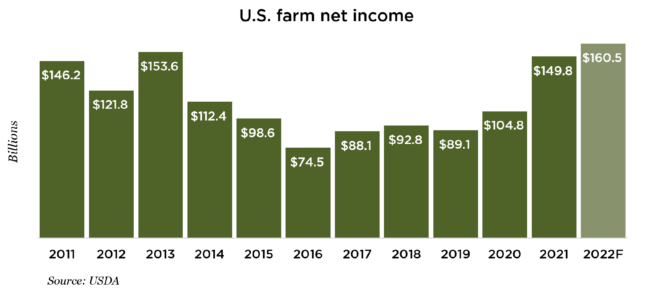2022 was a record-breaking year for net farm incomes
After a record-breaking 2022, farm profit margins expected to face headwinds in 2023
2021 saw a record high for U.S. farm net income – a broad measure of farm profits – but the record was short-lived as it was surpassed in 2022, according to the latest estimates from the USDA. Net farm income was up 13.8 percent year-over-year in 2022 and up 70 percent from 2020’s number, which was already elevated in comparison to the half-decade leading up to it. Even after adjusting for inflation, 2022’s farm net income would be the highest figure since 1973. It’s likely, however, that the numerous and significant headwinds facing farms in 2023 are likely to reverse this recent trend of rising farm profits.
-
Farm input inflation slowed toward the end of 2022, but the costs themselves are still extremely high. The prices paid indices for both commodities and services as well as production (inclusive of interest, taxes, and wage rates) were both at their highest levels on record as of November.
-
Farm worker availability remains a pressing concern for farm owners, driving wages higher across the industry. This could be alleviated to some extent by a potential economic downturn which could ease demand for labor in service industries or construction work. Still, even if the market loosens over 2023, worker availability is likely to be a concern for the foreseeable future as the farm worker shortage predates the current widespread labor shortage.
-
The combination of a still strong dollar and weaker global economy is likely to hurt ag exports, decreasing overall demand for U.S. ag goods. Additionally, tensions continue to rise with China, and Beijing seems intent to minimize imports from the U.S. by replacing them with purchases from other countries (note the recent decision to allow corn shipments from Brazil, the largest U.S. competitor in the international grain and oilseed market).
-
This has been covered in this space a couple times recently but, as CoBank points out in its 2023 outlook, the western half of the U.S. is entering what will likely be its third-straight growing season with widespread droughts due to La Niña weather conditions – hurting yields and farm revenues in the region.
-
In positive news, the price outlook for grains such as corn, wheat, and soybeans is higher due to a relatively low global supply. Elevated prices will be necessary to break even on many crops, however, due to high input costs for farmers.(USDA) (CoBank))

Ag News Highlights
Costs for eggs still surging
Egg prices are still soaring as the bird flu continues to ravage hen houses. Bird flu has killed more than 58 million birds (including 41 million egg-laying hens) since the beginning of 2022, making the current outbreak the deadliest in U.S. history. December’s average price for a dozen eggs ($4.74) shattered the previous record high set only a month prior, and the month-over-month increase from November was also the largest on record. For comparison, the price for a dozen eggs in January 2022 (just prior to the current bird flu outbreak) was $1.29.
Now that the holiday-related bump in demand for eggs has passed, wholesale egg prices are down from their December highs, according to Brian Moscogiuri, global trade strategist at Eggs Unlimited. Even if retail prices follow in the coming months, however, egg prices should be elevated for some time with little end in sight for the avian flu. (Axios)
Ag Barometer spikes after strong year
The Purdue University/CME Group Ag Barometer climbed in December to its highest level since August 2021, boosted by an especially large jump in farmers’ assessment of current conditions. The more positive view is due to a higher share of producers expecting better financial performance in 2023 than last year, and a lower percentage expecting weaker performance.
James Mintert and Micharl Langemeier of the Purdue Center for Commercial Agriculture assert the upbeat assessment could be due to income from the 2022 harvest season being stronger than expected (the 2022 farm net income numbers are detailed on page 2). Ag commodity prices were elevated for all of 2022 and export disruptions from the war in Ukraine undoubtedly boosted the bottom lines of many U.S. growers.
The farm capital investment index increased to its best reading since February but remained at a relatively subdued level. Farmers continue to report high prices for machinery and new construction as the biggest impediment to making large investments but rising interest rates have been a rising concern. The higher loan rates seem likely to continue in 2023. (Purdue University)
Drought concerns remain after California rainfall
While severe flooding in California has had minor negative impacts (e.g., disruptions in planting for some crops), farmers remain more concerned about access to water for summer crops. Despite the heavy rainfall, drought conditions remain and are expected to worsen, and the primary concern is the availability of water for crops like nuts, tomatoes, and cotton. (Fox Weather)
Citations/Disclaimers
-
The information in this report is provided by Nationwide Economics and is general in nature and not intended as investment or economic advice, or a recommendation to buy or sell any security or adopt any investment strategy. Additionally, it does not take into account any specific investment objectives, tax and financial condition or particular needs of any specific person.
The economic and market forecasts reflect our opinion as of the date of this report and are subject to change without notice. These forecasts show a broad range of possible outcomes. Because they are subject to high levels of uncertainty, they will not reflect actual performance. We obtained certain information from sources deemed reliable, but we do not guarantee its accuracy, completeness or fairness.

